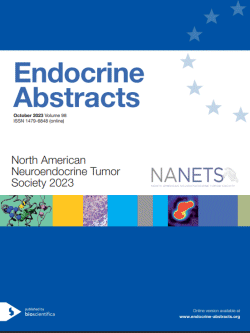Abstracts
Clinical – Surgery/Applied Pathology
ea0098c43 | Clinical – Surgery/Applied Pathology | NANETS2023
Accuracy of DOTATATE PET imaging in the preoperative planning of small bowel neuroendocrine tumor resection
Zhang, MD Chi , Gudmundsdottir, MD Hallbera , Takahashi, MD, PhD Hiroaki , Day, MS Courtney , Glasgow, MHA Amy , Wasif, MD, MPH Nabil , Starlinger, MD Patrick , Warner, MD Susanne , Grotz, MD Travis , Smoot, MD Rory , Truty, MD Mark , Cleary, MD Sean , Kendrick, MD Michael , Nagorney, MD David , Navin, MB, BCh Patrick , Halfdanarson, MD Thorvardur R. , Thiels, DO, MBA Cornelius
ea0098c44 | Clinical – Surgery/Applied Pathology | NANETS2023
Real-time prospective DAXX/ATRX testing of 186 consecutive surgically resected pancreatic neuroendocrine tumors reveals loss of expression correlates with distant metastasis
D Bell, Katelyn Smith Phoenix , Paniccia Alessandro , K Lee Kenneth , F Pingpank James , Hogg Melissa , J Zeh Herbert , N Nikiforov Marina , D Singhi Aatur , H Zureikat Amer
ea0098c45 | Clinical – Surgery/Applied Pathology | NANETS2023
Grade progression in gastrointestinal neuroendocrine tumors
Hill-Fung Lau Bryan , Moon Farhana , Joseph Nancy , Nakakura Eric , Khuong Le Bryan , Wang Stephanie , Zhang Li , Bergsland Emily
ea0098c46 | Clinical – Surgery/Applied Pathology | NANETS2023
Peptide receptor radionuclide therapy improves survival in patients who progress after resection of gastroenteropancreatic neuroendocrine tumors
Borbon Luis C. , Sherman Scott K. , Breheny Patrick , Ear Po H. , Menda Yusuf , Chandrasekharan Chandrikha , Bellizzi Andrew M. , O'Dorisio Thomas M. , Dillon Joseph S. , Howe James R
ea0098c47 | Clinical – Surgery/Applied Pathology | NANETS2023
Surgical cytoreduction vs systemic therapy in patients with metastatic gastroenteropancreatic neuroendocrine tumors (GEP-NETS): NCDB analysis
Mohamed A. , Fasih A. , Ocuin L.M. , Winter J. , Ammori J. , Hardacre J. , Mahipal A. , Bajor D. , Chakrabarti S. , Asa S.L. , Selfridge J.E. , Tirumani S.H. , Henke L.E. , Hoehn R.S
ea0098c48 | Clinical – Surgery/Applied Pathology | NANETS2023
Predictors of low-to-high grade progression in pancreatic neuroendocrine tumors
Wang Stephanie J. , Moon Farhana , Joseph Nancy , Nakakura Eric , Khuong Le Bryan , Zhang Li , Bergsland Emily
ea0098c49 | Clinical – Surgery/Applied Pathology | NANETS2023
Post-procedure outcomes of liver-directed therapy of neuroendocrine liver metastases
Meloche-Dumas Leamarie , Mercier Frederic , Barabash Victoria , Law Calvin , Singh Simron , Myrehaug Sten , Chan Wing , Hallet Julie
ea0098c50 | Clinical – Surgery/Applied Pathology | NANETS2023
Phenotype Genotype Correlation in Multiple Endocrine Neoplasia Type 1
Worthy Charlita , Vikram Nayan U. , Tora Rana , Welch James , Ninan Anisha , Bliss Lynn , Cochran Craig , S Weinstein Lee , Simonds William F. , Blau Jenny E. , Agarwal Sunita K. , Jha Smita
ea0098c51 | Clinical – Surgery/Applied Pathology | NANETS2023
A prospective phase ii single-arm trial on neoadjuvant peptide receptor radionuclide therapy (PRRT) with 177Lu-DOTATATE followed by surgery for pancreatic neuroendocrine tumors (NeoLuPaNET)
Partelli Stefano , Landoni Luca , Bartolomei Mirco , Zerbi Alessandro , Maria Grana Chiara , Boggi Ugo , Butturini Giovanni , Casadei Riccardo , Bassi Claudio , Falconi Massimo
ea0098c52 | Clinical – Surgery/Applied Pathology | NANETS2023
Translational potential of a receptor-targeted contrast agent for fluorescence-guided applications in pancreatic neuroendocrine tumors
AghaAmiri Solmaz , Estrella Jeannelyn S. , Hurd Mark W. , Hernandez Vargas Servando , Ghosh Sukhen C. , Azhdarinia Ali , Ikoma Naruhiko
ea0098c54 | Clinical – Surgery/Applied Pathology | NANETS2023
Tissue section thickness of Ki67 immunohistochemistry does not have a correlative effect on pancreatic neuroendocrine tumor grading
Ng Moreen , Sinard John , Kunstman John , Kunz Pam , Misdraji Joseph
ea0098c55 | Clinical – Surgery/Applied Pathology | NANETS2023
Association of long-term PPI use with low-risk gastric neuroendocrine tumor
Al-Toubah MPH Taymeyah , Pelle MD Eleonora , Strosberg MD Jonathan
ea0098c56 | Clinical – Surgery/Applied Pathology | NANETS2023
Comparative gene expression and pathway analysis of neuroendocrine neoplasms in relation to clinical outcomes and tumor location
Laderian Bahar , Saberzadeh Ardestani Bahar , Chen Yanwen , Mohamed Amr , Ni Ying , Mundi Prabhjot
ea0098c57 | Clinical – Surgery/Applied Pathology | NANETS2023
Perioperative management of carcinoid crisis: protocol for a modified Delphi international expert consensus statement with patient engagement
Hallet Julie , Alam Fahad , Rocha Flavio , Del Rivero Jaydira , Partelli Stefano , Koea Jonathan , Ladowski Stephanie , Saliba Chadi , Pommier Rodney
ea0098c58 | Clinical – Surgery/Applied Pathology | NANETS2023
Do Pancreatic Well-differentiated Neuroendocrine Tumor (NET) Progress to Poorly-differentiated Neuroendocrine Carcinoma (NEC)?
Joseph Nancy , Umetsu Sarah , Kakar Sanjay , Wang Stephanie J. , Nakakura Eric , Paciorek Alan , Khuong Le Bryan , Moon Farhana , Bergsland Emily
ea0098c59 | Clinical – Surgery/Applied Pathology | NANETS2023
High grade medullary thyroid carcinoma predicts greater lymph node burden in the ipsilateral lateral neck
Nigam Aradhya , Xu Bin , Spanheimer Philip M. , Ganly Ian , Michael Tuttle R. , Wong Richard J. , Shaha Ashok R. , Ghossein Ronald A. , Untch Brian R.




